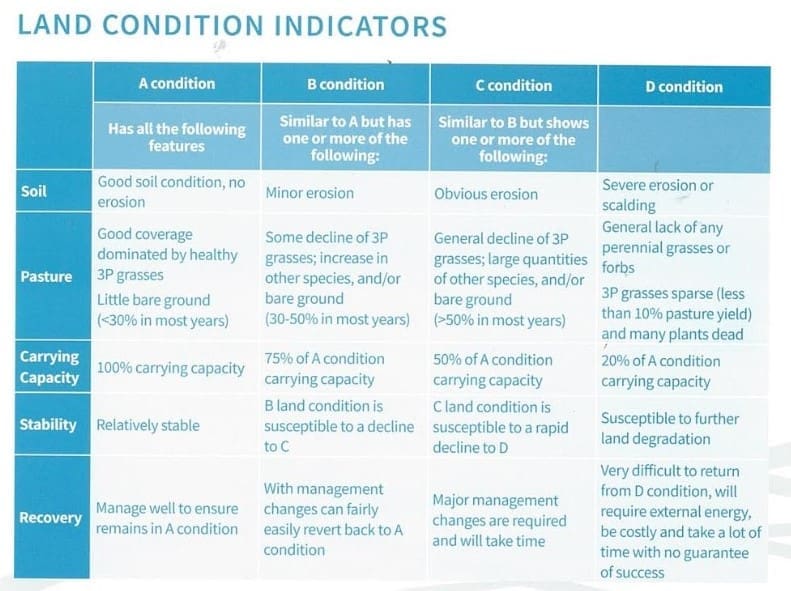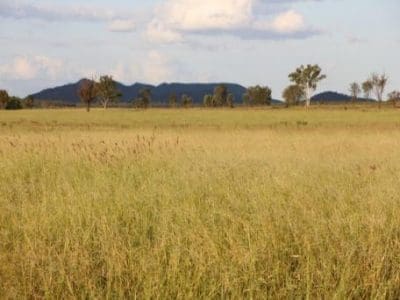BUYING property can be all about taking up an opportunity with potential, but land management and condition is increasingly being seen as an attribute with the potential to impact the final market value of a landholding.
The grazing land condition ABCD framework of the EDGEnetwork Grazing Land Management education package (see table below) is an example of an assessment approach that has had widespread uptake by grazing land managers. It is now a well-established procedure in northern Australia.
It uses a simple ABCD rating and provides an interesting table of inherent land condition descriptions and the resulting carrying capacity discounts.

Source: Land Condition Guide, Southern Gulf NRM and Pasture Partners material. Click on image for a larger view
Herron Todd White’s north and northwest Queensland regional property valuer Roger Hill says many ‘quietly spoken’ graziers and farmers have been regenerating their land condition for years.

Roger Hill
“Over the past 25 to 40 years, some clients have been reinvesting in their management systems (including fencing and water distribution) to improve their pasture yield and composition,” he said.
“As a result, they have increasing mulch layers, longer grass-growing periods, narrower protein drought impacts (seasonality), lower business risk, their stock grazing days per hectare per annum is superior to that of the neighbours, and their gross profit mirrors that performance,” Mr Hill said.
Proof is in the pudding
He suggested that there have been two recent public property auctions and private treaty sales, where vendors were rewarded for their efforts and investment in land condition.
Examples include Muttaburra’s Stockholm Station, in Queensland’s Central West, which attracted 20 bids from six interested parties when it was auctioned at the end of April.
The 11,857ha Mitchell and buffel grass grazing property which had incredible feed following recent rain and storms, as well as excellent water improvements, sold under the hammer for $3.85m bare or $324/ha.
And in June, Fairlight, a 45,300ha dual-purpose fattening or breeding property, 56km north of Hughenden, exceeded price expectations of $11m to $13m, selling at auction for $14.1m bare of livestock, plant and equipment.
Mr Hill said the underlying property market often rewarded vendors for selling their properties in what was deemed to be ‘good land condition’, with value rates that were above the general parameters for the land type in that locality.

Good land condition contributed to the sale of Liontown, a 15,100ha property near Charters Towers, which made $470/ha bare when sold in 2015.
A prime example is the 15,154ha Charters Towers property Liontown which sold in May 2015. The blue-ribbon grazing property sold for $8.7m including cattle, plant and equipment.
Mr Hill said Liontown sold at a rate of $470/ha improved (after allowing for included cattle and plant), which was a credit to the vendor and agent.
“The property boasted proximity to town, a substantial body of grass, extensive land development, good land condition, good fencing, good water infrastructure and a history of weed control. At auction, the bidding was strong and spirited and the eventual sale price possibly indicated a 10 to 15 percent reward to the vendor.”
Mr Hill said three other sales occurred in the same month: Broadleigh Downs with very good water infrastructure at $233/ha improved, Devon Park at $350/ha and Gunnadoo at $350/ha.
“Each of these had their pluses and minuses. Liontown did present with a series of pluses that indicated a stronger hectare rate was applicable to that property,” he said.
Growing pastures into profit
Mr Hill said clients working on land condition were also achieving higher stocking rates per hectare, that could translate into a 10 to 25 percent land value premium if they were to sell their properties.
“The old mindset was to increase a property’s value and profitability by opening up more country and installing additional fences and troughs. But water and wire are only part of the development equation. If half the breeding is in the feeding, then surely the real business development investment is into practices that improves soil health, moisture retention and grows better feed,” he said.
Greater emphasis on land condition
Mr Hill foreshadows that over time, information regarding percentage of soil carbon, organic matter and land condition may become more relevant in the property sale/due diligence process.
Another catalyst for this is the Carbon agreements which are paid for by the Emissions Reduction Scheme.
“It is evident that land condition is presently one of the factors that contributes to the negotiated price for agricultural land. If grazing days per hectare per annum are higher because of the land condition, then the use to which that property can be put will determine its worth.”
Higher property prices longer term
 Alison Larad (pictured) is a 2018 Nuffield Scholar who also believes pasture condition is starting to impact land values.
Alison Larad (pictured) is a 2018 Nuffield Scholar who also believes pasture condition is starting to impact land values.
“It should become increasingly influential over the coming years, particularly as younger people return to the family farm and develop a better understanding of such issues.”
“When young people come back into the business, there is a fresh set of eyes and enthusiasm. Today, there is opportunity to do more with reasonable seasonal conditions and better cattle prices,” she said.
Ms Larad said during tough years, when seasonal and market conditions were poor, producers switched on ‘survival mode.’ However, when the situation eases, they can look at bigger picture issues and think more strategically.
“I don’t expect to see much impact on property prices in the short term. Issues impacting on property values and the quality of a place (as part of a grazing system) will need to form part of a longer-term strategy. But I am hopeful that the value of pasture condition will filter through and impact property prices. It is a long-term goal.”

Peter Honnef
As a director of agribusiness valuation for CBRE, Peter Honnef has extensive knowledge in property valuation over a 23-year period of operating in Northern Australia.
He said the producers he sees operating are running their places to the conditions.
“There are not many that run into trouble because they are bad managers. Knowledge and information is much more accessible to them and I am always impressed by how technical their knowledge is. They do their pasture budgets and use that to manage their grasses, which is their asset. The better a property’s condition, the more likely it is going to run a certain number of stock, which will then dictate its value at sale time.”
Mr Honnef said producers in a good financial position tended to think more strategically.
“Most producers are concerned and care about the condition of their property. Where that is lacking is financial pressure – that is when people push their properties because there is a need to make payments. But the first thing producers do when there’s a break in the season is to back off and give their country a spell.”
Market discounting
Mr Hill said company sales data within the last 10 years showed a 10 to 45 percent market discounting for Mitchell grass downs grazing properties exhibiting poor land condition.
“The market discounts more readily than it pays a premium,” he said.
When a property sells in good land condition, there were usually other positives around the quality, location and degree of fencing, water infrastructure and weed control that complimented and contributed to the premium.
Conversely, when the property market has paid a discount for land condition, there are usually other factors involved, including:
- Run down infrastructure
- Out of use farming blocks
- Weed infestations
- Compulsion – family issues and unfortunate financial circumstances
- Market conditions of the day
Mr Honnef said price discounts in terms of poor pasture condition were not always reflected in the sale price.
“Property prices are mostly affected by land degradation and the resulting reduction in carrying capacity. However most potential buyers expect a place that is bare to come back with seasons and spelling, and mostly that is true because the land is quite resilient.”
“I cannot put a finger on a single property that transacted better, purely due to pasture condition. There are always other factors to consider. The properties that are most appealing are those that are presented well, with historical records showing the place is in good condition, has been nicely spelled with a mix of pastures, good fencing, maintained roads and solid management,” Mr Honnef said.
Conclusion
HTW’s Roger Hill said there was no perfect market evidence that purely isolated the land or soil condition to clinically identify a market premium or discount.
“At present, the degree of market reward or discount appears to vary depending on the market cycle of the day,” he said.
But the situation could evolve, according to Alison Larad.
“In the future, banks could look at pasture condition as a risk management tool. A place that is well-managed with good perennial and pasture grasses, is inherently less risky, and so are the businesses utilising them.”
